3.6: Large Intestine
- Page ID
- 40941
\( \newcommand{\vecs}[1]{\overset { \scriptstyle \rightharpoonup} {\mathbf{#1}} } \)
\( \newcommand{\vecd}[1]{\overset{-\!-\!\rightharpoonup}{\vphantom{a}\smash {#1}}} \)
\( \newcommand{\dsum}{\displaystyle\sum\limits} \)
\( \newcommand{\dint}{\displaystyle\int\limits} \)
\( \newcommand{\dlim}{\displaystyle\lim\limits} \)
\( \newcommand{\id}{\mathrm{id}}\) \( \newcommand{\Span}{\mathrm{span}}\)
( \newcommand{\kernel}{\mathrm{null}\,}\) \( \newcommand{\range}{\mathrm{range}\,}\)
\( \newcommand{\RealPart}{\mathrm{Re}}\) \( \newcommand{\ImaginaryPart}{\mathrm{Im}}\)
\( \newcommand{\Argument}{\mathrm{Arg}}\) \( \newcommand{\norm}[1]{\| #1 \|}\)
\( \newcommand{\inner}[2]{\langle #1, #2 \rangle}\)
\( \newcommand{\Span}{\mathrm{span}}\)
\( \newcommand{\id}{\mathrm{id}}\)
\( \newcommand{\Span}{\mathrm{span}}\)
\( \newcommand{\kernel}{\mathrm{null}\,}\)
\( \newcommand{\range}{\mathrm{range}\,}\)
\( \newcommand{\RealPart}{\mathrm{Re}}\)
\( \newcommand{\ImaginaryPart}{\mathrm{Im}}\)
\( \newcommand{\Argument}{\mathrm{Arg}}\)
\( \newcommand{\norm}[1]{\| #1 \|}\)
\( \newcommand{\inner}[2]{\langle #1, #2 \rangle}\)
\( \newcommand{\Span}{\mathrm{span}}\) \( \newcommand{\AA}{\unicode[.8,0]{x212B}}\)
\( \newcommand{\vectorA}[1]{\vec{#1}} % arrow\)
\( \newcommand{\vectorAt}[1]{\vec{\text{#1}}} % arrow\)
\( \newcommand{\vectorB}[1]{\overset { \scriptstyle \rightharpoonup} {\mathbf{#1}} } \)
\( \newcommand{\vectorC}[1]{\textbf{#1}} \)
\( \newcommand{\vectorD}[1]{\overrightarrow{#1}} \)
\( \newcommand{\vectorDt}[1]{\overrightarrow{\text{#1}}} \)
\( \newcommand{\vectE}[1]{\overset{-\!-\!\rightharpoonup}{\vphantom{a}\smash{\mathbf {#1}}}} \)
\( \newcommand{\vecs}[1]{\overset { \scriptstyle \rightharpoonup} {\mathbf{#1}} } \)
\( \newcommand{\vecd}[1]{\overset{-\!-\!\rightharpoonup}{\vphantom{a}\smash {#1}}} \)
\(\newcommand{\avec}{\mathbf a}\) \(\newcommand{\bvec}{\mathbf b}\) \(\newcommand{\cvec}{\mathbf c}\) \(\newcommand{\dvec}{\mathbf d}\) \(\newcommand{\dtil}{\widetilde{\mathbf d}}\) \(\newcommand{\evec}{\mathbf e}\) \(\newcommand{\fvec}{\mathbf f}\) \(\newcommand{\nvec}{\mathbf n}\) \(\newcommand{\pvec}{\mathbf p}\) \(\newcommand{\qvec}{\mathbf q}\) \(\newcommand{\svec}{\mathbf s}\) \(\newcommand{\tvec}{\mathbf t}\) \(\newcommand{\uvec}{\mathbf u}\) \(\newcommand{\vvec}{\mathbf v}\) \(\newcommand{\wvec}{\mathbf w}\) \(\newcommand{\xvec}{\mathbf x}\) \(\newcommand{\yvec}{\mathbf y}\) \(\newcommand{\zvec}{\mathbf z}\) \(\newcommand{\rvec}{\mathbf r}\) \(\newcommand{\mvec}{\mathbf m}\) \(\newcommand{\zerovec}{\mathbf 0}\) \(\newcommand{\onevec}{\mathbf 1}\) \(\newcommand{\real}{\mathbb R}\) \(\newcommand{\twovec}[2]{\left[\begin{array}{r}#1 \\ #2 \end{array}\right]}\) \(\newcommand{\ctwovec}[2]{\left[\begin{array}{c}#1 \\ #2 \end{array}\right]}\) \(\newcommand{\threevec}[3]{\left[\begin{array}{r}#1 \\ #2 \\ #3 \end{array}\right]}\) \(\newcommand{\cthreevec}[3]{\left[\begin{array}{c}#1 \\ #2 \\ #3 \end{array}\right]}\) \(\newcommand{\fourvec}[4]{\left[\begin{array}{r}#1 \\ #2 \\ #3 \\ #4 \end{array}\right]}\) \(\newcommand{\cfourvec}[4]{\left[\begin{array}{c}#1 \\ #2 \\ #3 \\ #4 \end{array}\right]}\) \(\newcommand{\fivevec}[5]{\left[\begin{array}{r}#1 \\ #2 \\ #3 \\ #4 \\ #5 \\ \end{array}\right]}\) \(\newcommand{\cfivevec}[5]{\left[\begin{array}{c}#1 \\ #2 \\ #3 \\ #4 \\ #5 \\ \end{array}\right]}\) \(\newcommand{\mattwo}[4]{\left[\begin{array}{rr}#1 \amp #2 \\ #3 \amp #4 \\ \end{array}\right]}\) \(\newcommand{\laspan}[1]{\text{Span}\{#1\}}\) \(\newcommand{\bcal}{\cal B}\) \(\newcommand{\ccal}{\cal C}\) \(\newcommand{\scal}{\cal S}\) \(\newcommand{\wcal}{\cal W}\) \(\newcommand{\ecal}{\cal E}\) \(\newcommand{\coords}[2]{\left\{#1\right\}_{#2}}\) \(\newcommand{\gray}[1]{\color{gray}{#1}}\) \(\newcommand{\lgray}[1]{\color{lightgray}{#1}}\) \(\newcommand{\rank}{\operatorname{rank}}\) \(\newcommand{\row}{\text{Row}}\) \(\newcommand{\col}{\text{Col}}\) \(\renewcommand{\row}{\text{Row}}\) \(\newcommand{\nul}{\text{Nul}}\) \(\newcommand{\var}{\text{Var}}\) \(\newcommand{\corr}{\text{corr}}\) \(\newcommand{\len}[1]{\left|#1\right|}\) \(\newcommand{\bbar}{\overline{\bvec}}\) \(\newcommand{\bhat}{\widehat{\bvec}}\) \(\newcommand{\bperp}{\bvec^\perp}\) \(\newcommand{\xhat}{\widehat{\xvec}}\) \(\newcommand{\vhat}{\widehat{\vvec}}\) \(\newcommand{\uhat}{\widehat{\uvec}}\) \(\newcommand{\what}{\widehat{\wvec}}\) \(\newcommand{\Sighat}{\widehat{\Sigma}}\) \(\newcommand{\lt}{<}\) \(\newcommand{\gt}{>}\) \(\newcommand{\amp}{&}\) \(\definecolor{fillinmathshade}{gray}{0.9}\)We have reached a fork in the road. We could follow the uptake of the digested compounds into the enterocyte or we could finish following what has escaped digestion and is going to continue into the large intestine. Obviously from the title of this section we are going to do the latter. As we learned previously, fiber is a crude term for physical material (since there is some water as well) has survived digestion and reached the large intestine.

The ileocecal valve is the sphincter between the ileum and the large intestine. This name should make more sense as we go through the anatomy of the large intestine.
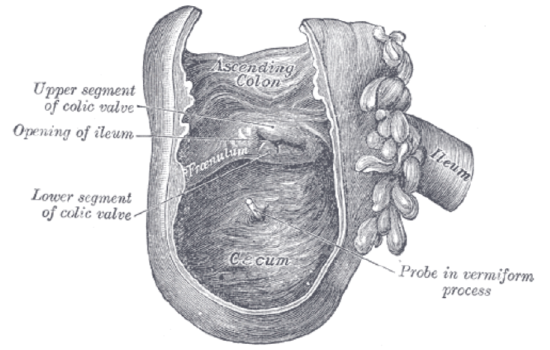
The large intestine consists of the colon, the rectum, and the anus. The colon can be further divided into the cecum (hence the -cecal in ileocecal valve, ileo- refers to ileum), ascending colon, transverse colon, descending colon, and sigmoid colon as shown below.
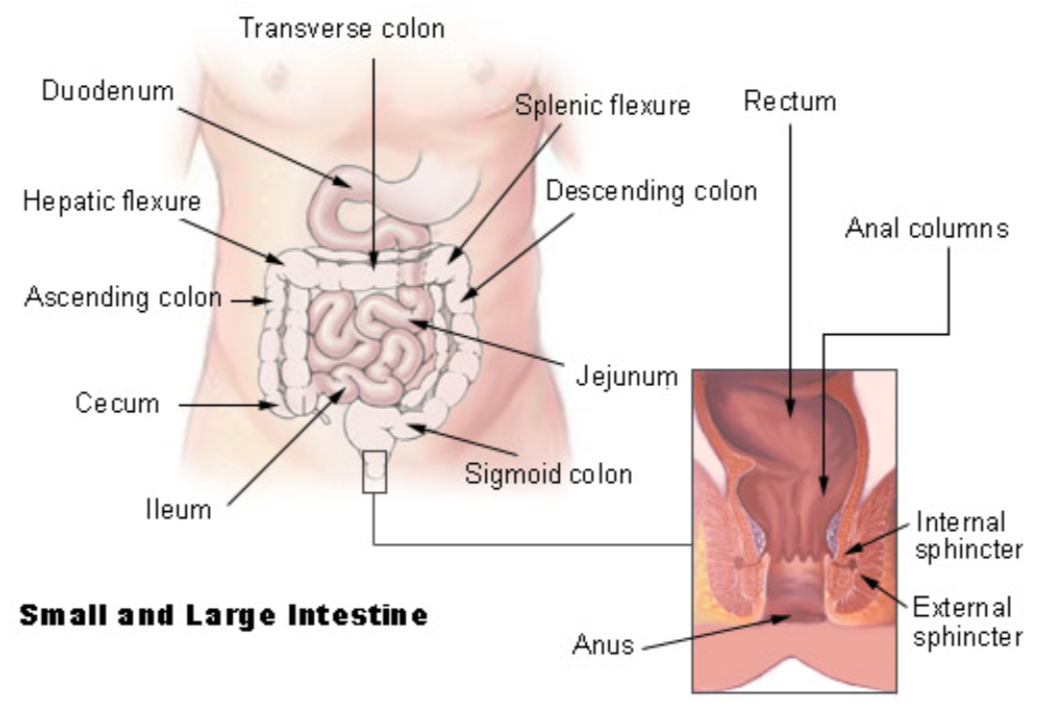
The large intestine is responsible for absorbing the remaining water and electrolytes (sodium, potassium, and chloride). It also forms and excretes feces. The large intestine contains large amounts of microorganisms like those shown in the figure below.
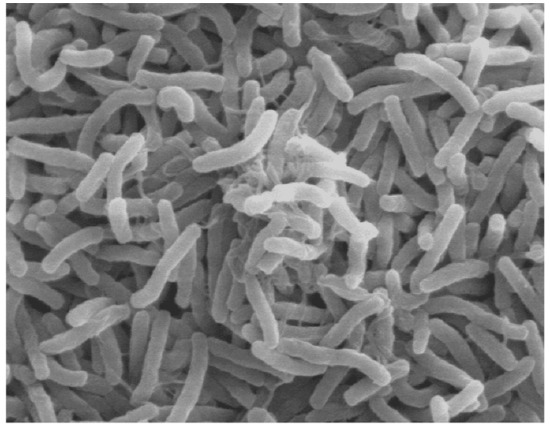
The large intestine can also be referred to as the gut. There are a large number of microorganisms found throughout the gastrointestinal tract that collectively are referred to as the flora, microflora, or microbiota. Technically, microbiota is the preferred term because flora means "pertaining to plants". There are 10 times more microorganisms in the gastrointestinal tract than cells in the whole human body4. As can be seen in the figure below, the density of microorganisms increases as you move down the digestive tract.
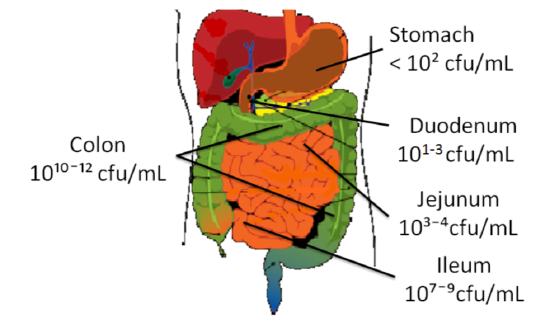
As described in the fiber sections, there are two different fates for fiber once it reaches the large intestine. The fermentable, viscous fiber is fermented by bacteria. An example of fermentation is the utilization of the oligosaccharides raffinose and stachyose by microorganisms that results in the production of gas, which can lead to flatulence. Also, some bile acids are fermented by microorganisms to form secondary bile acids that can be reabsorbed. These secondary bile acids represent approximately 20% of the total bile acids in our body. Fermentable fibers can be used to form short-chain fatty acids that can then be absorbed and used by the body. The nonfermentable, nonviscous fiber is not really altered and will be a component of feces, that is then excreted through the rectum and anus. This process involves both an internal and external sphincter that are shown in Figure \(\PageIndex{3}\) above.
Query \(\PageIndex{1}\)
Query \(\PageIndex{2}\)
Microbiota
There is increased attention given to the potential of a person's microbiota to impact health. This is because there are beneficial and nonbeneficial bacteria inhabiting our gastrointestinal tracts. Thus, theoretically, if you can increase the beneficial or decrease the non- beneficial bacteria, there may be improved health outcomes. In response to this, probiotics and prebiotics have been identified/developed. A probiotic is a live microorganism that is consumed, and colonizes in the body as shown in the figures below.
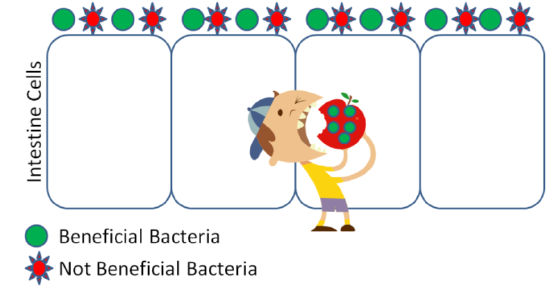
A prebiotic is a nondigestible food component that selectively stimulates the growth of beneficial intestinal bacteria. Typically the food component is fermented by the bacteria. An example of a prebiotic is inulin, which is shown in the figure below.
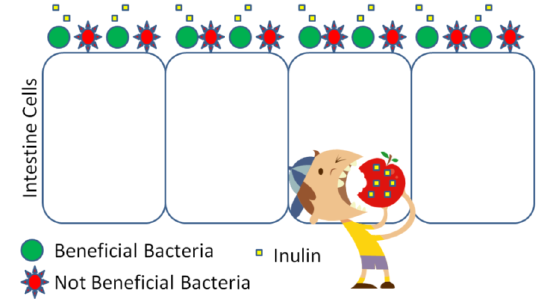
The net result is the same for both prebiotics and probiotics, an increase in the beneficial/non beneficial microorganism ratio.
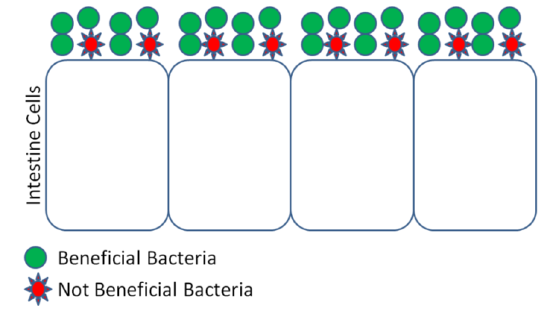
The following video does a nice job of explaining and illustrating how probiotics work.
The NCCAM website is a good source of information if you have further questions on the topic.
Web Links
Some common examples of probiotics are DanActive® and Activia®.
The claims that companies made about their produce probiotic products have come under scrutiny. Dannon settled with the US Federal Trade Commission to drop claims that its probiotic products will help prevent colds or alleviate digestive problems, as seen in the top link below. General Mills also settled a lawsuit that accused them of falsely advertising the digestive benefits of Yo-Plus a product it no longer sells, as seen in the second link.
Some examples of prebiotics include inulin, other fructose-containing oligosaccharides and polysaccharides, and resistant starch. Inulin is an oligosaccharide that contains mainly fructoses that are joined by beta-bonds, which allows them to survive digestion. The structure of inulin is shown below.

Resistant starch is so named because it is a starch that is resistant to digestion. As a result, it arrives in the colon to be fermented.
A couple of newer terms related to the microbiota that are increasingly being used are:
- A synbiotic is a product that contains both probiotics and prebiotics. The syn-part of the term is meant to indicate that there may be synergy by the combination of the two.
- Postbiotics are metabolites secreted by the microbiota. There is increased interest in the impact of these metabolites rather than just focusing on the population of the microbiota.
Query \(\PageIndex{3}\)
References
- commons.wikimedia.org/wiki/File:Gray1075.png
- en.Wikipedia.org/wiki/Image:Illu_intestine.jpg
- commons.wikimedia.org/wiki/Im...cteria_SEM.jpg
- Guarner F, Malagelada J. (2003) Gut flora in health and disease. The Lancet 361(9356): 512.
- DiBaise J, Zhang H, Crowell M, Krajmalnik-Brown R, Decker , et al. (2008) Gut microbiota and its possible relationship with obesity. Mayo Clin Proc 83(4): 460.
- Adapted from: http://www.wpclipart.com/medical/ana..._page.png.html
- en.Wikipedia.org/wiki/File:In...kturformel.png
- Douglas L, Sanders M. (2008) Probiotics and prebiotics in dietetics practice. American Dietetic Association.Journal of the American Dietetic Association 108(3): 510.


